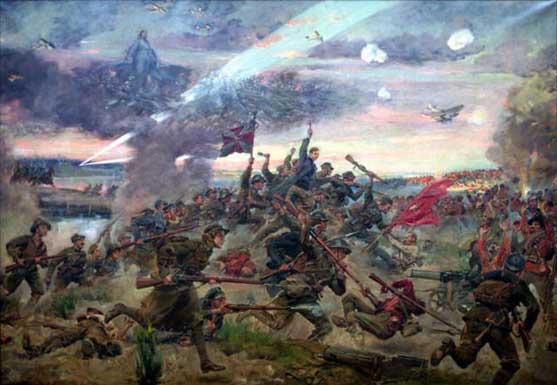| White
Eagle Rising
By William Sariego
September 2015
Few nations have as tumultuous a history
as Poland. Once a great nation and empire,
it had been carved up between the surrounding
Imperial states of Austria-Hungary, German
and Tsarist Russia. Only in the wake of the
Great War was Poland able to reconstitute
itself as an independent country. After the
demise of Imperial Russia, Poland and the
Baltic States gained independence, which
was in line with the pre-war Bolshevik policy
on autonomy of subject peoples.
For some, however, mere independence was
not enough. Such an individual was the dynamic
Marshal Jozef Pilsudski. Pilsudski dreamed
of Poland becoming a dominant power in the
region and would use any means diplomatic
or military to fulfill this aim. Pilsudski
hoped to take advantage of the Civil War
in Russia to further expand Polish borders.
As part of this vision he wished an independent
Ukraine, indebted to Poland for its autonomy,
as a buffer to whatever side emerged victorious
in Russia. To this end he cultivated the
friendship of Atman Simon Petlura, leader
of the pro-independence forces in Ukraine.
On April 24th 1920, just two days after a
military agreement was signed between them,
Polish military forces entered Ukraine.

Ukrainian nationalist army recruiting
poster. This may explain why they attracted
few volunteers.
The offensive was well-timed. The Red Army
was poorly placed to repel the Poles, and
its better elements were tied up in the Crimea.
The Polish “liberation” of the
Ukraine may have succeeded, but it appeared
more of a conquest as Petlura could only
contribute a weak cavalry regiment and infantry
battalion and lacked much popular support.
Soon Pilsudski would charge him with building
up a full Ukrainian army by the end of May.
The Bolsheviks were quick to react and he
would have precious little time to train
a large force to be cannon fodder for the
Poles.
The counter attack on the Southern front
was lead by the Buddenny’s Konarmiya.
This massive cavalry force, a relic of another
age, was still a powerful fighting machine
on the steppes. Covering up to 25 miles a
day, they shattered the allies' resistance
south of the Pripet Marshes. The Poles managed
to retreat with a measure of good order while
the Ukrainians melted away. Attacks north
of the Pripet Marshes would begin in early
June, with the Poles falling back on interior
lines toward Warsaw. The wide front, separated
by near impassable terrain and the friction
between the Red Army commanders of the North-Western
(Tukachevsky) Front north of the Marshes
and South-Western Front (Yegorov, with Stalin)
in the south hampered coordination and a
decisive conclusion to the initial counter-offensive.

Troopers of the Konarmiya.
As the Poles were steadily pushed back on
both fronts the diplomats attempted to intervene,
with British Prime Minister David Lloyd George
taking special interest in the matter. Bolshevik
confidence was high, however, following both
their success in this campaign and their
defeat of the latest White threat in the
Crimea. In the end diplomacy amounted to
nothing, and aid to Poland from the Western
Powers was scant, as many Unions and working
organizations delayed or refused shipment
of goods. France did send some military advisors,
chief among them General Maxime Weygand.
Poland thus would live or die on its own.
Retreating to interior lines, they made their
stand on the Vistula River. Helped by lack
of over all strategic direction of the Red
Army (the South-Western Front especially
fragmenting its efforts towards differing
objectives) Pilsudski found himself in a
good position militarily, despite conventional
wisdom writing off Poland’s chance
of survival.
 The Miracle on the Vistula. The Miracle on the Vistula.
The battles that became “The Miracle
on the Vistula” opened on August 10th
when Cossacks crossed the river in order
to attack Warsaw from the rear. Initial attacks
from the east were repulsed on the 13th.
The counterattack by the Polish 5th Army
under Sikorski began the following day. The
exhausted Reds were pushed back and on the
16th the weakly-held gap between the two
Fronts was exposed and exploited by Pilsudki’s
reserves. Once more it was the Poles advancing
across the frontlines steadily until late
September when negotiations for peace began
in earnest by both sides. An armistice went
into effect on October 18th. While the peace
negotiations were in progress between Poland
and Russia, Petlura was still fighting in
the Ukraine. His army would finally be crushed
and retreat into Poland in late November.
A peace treaty would be signed at Riga on
October 25th, 1920. Poland would fulfill
most of her territorial ambitions, including
Vilnius, effectively stolen from Lithuania.
The separate peace left the Ukrainians out
to dry, a sore point of honor for Pilsudski
who would be displeased by the entire treaty,
wanting even more territory. Poland would
have her independence but not security. This
point would be amply driven home by Hitler
and Stalin in 1939.
Poland is a major factor
in our game Red Russia — order now!
|
